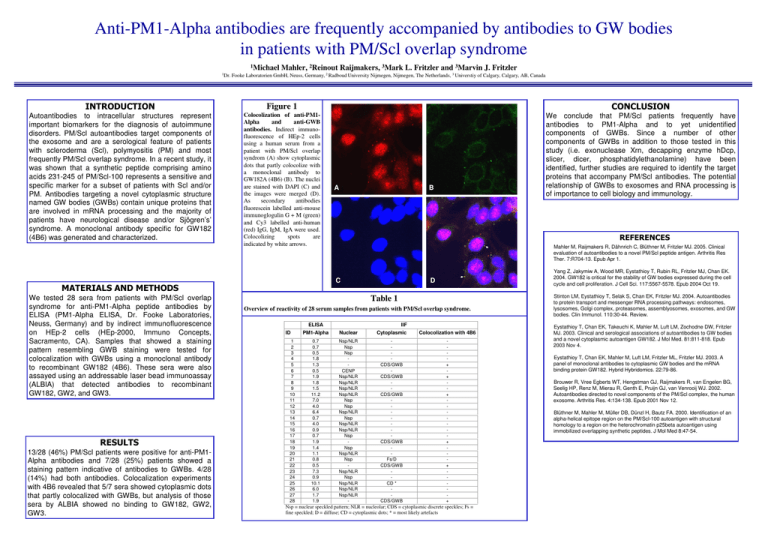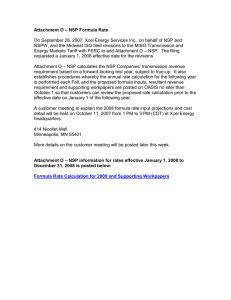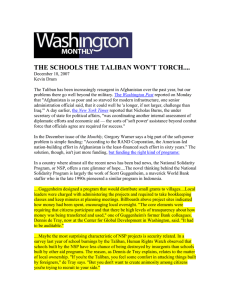Anti-PM1-Alpha antibodies are frequently accompanied by
advertisement

Anti-PM1-Alpha antibodies are frequently accompanied by antibodies to GW bodies in patients with PM/Scl overlap syndrome 1Michael 1Dr. Mahler, 2Reinout Raijmakers, 3Mark L. Fritzler and 3Marvin J. Fritzler Fooke Laboratorien GmbH, Neuss, Germany, 2 Radboud University Nijmegen, Nijmegen, The Netherlands, 3 Universtiy of Calgary, Calgary, AB, Canada INTRODUCTION Figure 1 CONCLUSION Autoantibodies to intracellular structures represent important biomarkers for the diagnosis of autoimmune disorders. PM/Scl autoantibodies target components of the exosome and are a serological feature of patients with scleroderma (Scl), polymyositis (PM) and most frequently PM/Scl overlap syndrome. In a recent study, it was shown that a synthetic peptide comprising amino acids 231-245 of PM/Scl-100 represents a sensitive and specific marker for a subset of patients with Scl and/or PM. Antibodies targeting a novel cytoplasmic structure named GW bodies (GWBs) contain unique proteins that are involved in mRNA processing and the majority of patients have neurological disease and/or Sjögren’s’ syndrome. A monoclonal antibody specific for GW182 (4B6) was generated and characterized. Colocolization of anti-PM1Alpha and anti-GWB antibodies. Indirect immunofluorescence of HEp-2 cells using a human serum from a patient with PM/Scl overlap syndrom (A) show cytoplasmic dots that partly colocolize with a monoclonal antibody to GW182A (4B6) (B). The nuclei are stained with DAPI (C) and the images were merged (D). As secondary antibodies fluorescein labelled anti-mouse immunoglogulin G + M (green) and Cy3 labelled anti-human (red) IgG, IgM, IgA were used. Colocolizing spots are indicated by white arrows. We conclude that PM/Scl patients frequently have antibodies to PM1-Alpha and to yet unidentified components of GWBs. Since a number of other components of GWBs in addition to those tested in this study (i.e. exonuclease Xrn, decapping enzyme hDcp, slicer, dicer, phosphatidylethanolamine) have been identified, further studies are required to identify the target proteins that accompany PM/Scl antibodies. The potential relationship of GWBs to exosomes and RNA processing is of importance to cell biology and immunology. A B REFERENCES Mahler M, Raijmakers R, Dähnrich C, Blüthner M, Fritzler MJ. 2005. Clinical evaluation of autoantibodies to a novel PM/Scl peptide antigen. Arthritis Res Ther. 7:R704-13. Epub Apr 1. C Yang Z, Jakymiw A, Wood MR, Eystathioy T, Rubin RL, Fritzler MJ, Chan EK. 2004. GW182 is critical for the stability of GW bodies expressed during the cell cycle and cell proliferation. J Cell Sci. 117:5567-5578. Epub 2004 Oct 19. D MATERIALS AND METHODS We tested 28 sera from patients with PM/Scl overlap syndrome for anti-PM1-Alpha peptide antibodies by ELISA (PM1-Alpha ELISA, Dr. Fooke Laboratories, Neuss, Germany) and by indirect immunofluorescence on HEp-2 cells (HEp-2000, Immuno Concepts, Sacramento, CA). Samples that showed a staining pattern resembling GWB staining were tested for colocalization with GWBs using a monoclonal antibody to recombinant GW182 (4B6). These sera were also assayed using an addressable laser bead immunoassay (ALBIA) that detected antibodies to recombinant GW182, GW2, and GW3. RESULTS 13/28 (46%) PM/Scl patients were positive for anti-PM1Alpha antibodies and 7/28 (25%) patients showed a staining pattern indicative of antibodies to GWBs. 4/28 (14%) had both antibodies. Colocalization experiments with 4B6 revealed that 5/7 sera showed cytoplasmic dots that partly colocalized with GWBs, but analysis of those sera by ALBIA showed no binding to GW182, GW2, GW3. Table 1 Overview of reactivity of 28 serum samples from patients with PM/Scl overlap syndrome. ELISA ID 1 2 3 4 5 6 7 8 9 10 11 12 13 14 15 16 17 18 19 20 21 22 23 24 25 26 27 28 IIF PM1-Alpha Nuclear Cytoplasmic Colocolization with 4B6 0.7 0.7 0.5 1.8 1.3 0.5 1.9 1.8 1.5 11.2 7.0 4.0 6.4 0.7 4.0 0.9 0.7 1.9 1.4 1.1 0.8 0.5 7.3 0.9 10.1 6.0 1.7 1.9 Nsp/NLR Nsp Nsp CENP Nsp/NLR Nsp/NLR Nsp/NLR Nsp/NLR Nsp Nsp Nsp/NLR Nsp Nsp/NLR Nsp/NLR Nsp Nsp Nsp/NLR Nsp Nsp/NLR Nsp Nsp/NLR Nsp/NLR Nsp/NLR - CDS/GWB CDS/GWB CDS/GWB CDS/GWB Fs/D CDS/GWB CD * CDS/GWB + + + + + + Nsp = nuclear speckled pattern; NLR = nucleolar; CDS = cytoplasmic discrete speckles; Fs = fine speckled; D = diffuse; CD = cytoplasmic dots; * = most likely artefacts Stinton LM, Eystathioy T, Selak S, Chan EK, Fritzler MJ. 2004. Autoantibodies to protein transport and messenger RNA processing pathways: endosomes, lysosomes, Golgi complex, proteasomes, assemblyosomes, exosomes, and GW bodies. Clin Immunol. 110:30-44. Review. Eystathioy T, Chan EK, Takeuchi K, Mahler M, Luft LM, Zochodne DW, Fritzler MJ. 2003. Clinical and serological associations of autoantibodies to GW bodies and a novel cytoplasmic autoantigen GW182. J Mol Med. 81:811-818. Epub 2003 Nov 4. Eystathioy T, Chan EK, Mahler M, Luft LM, Fritzler ML, Fritzler MJ. 2003. A panel of monoclonal antibodies to cytoplasmic GW bodies and the mRNA binding protein GW182. Hybrid Hybridomics. 22:79-86. Brouwer R, Vree Egberts WT, Hengstman GJ, Raijmakers R, van Engelen BG, Seelig HP, Renz M, Mierau R, Genth E, Pruijn GJ, van Venrooij WJ. 2002. Autoantibodies directed to novel components of the PM/Scl complex, the human exosome. Arthritis Res. 4:134-138. Epub 2001 Nov 12. Blüthner M, Mahler M, Müller DB, Dünzl H, Bautz FA. 2000. Identification of an alpha-helical epitope region on the PM/Scl-100 autoantigen with structural homology to a region on the heterochromatin p25beta autoantigen using immobilized overlapping synthetic peptides. J Mol Med 8:47-54.



